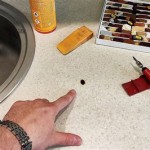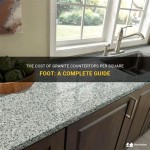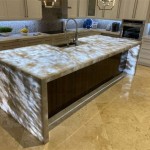Countertop Ice Maker That Connects To Water Line: A Comprehensive Guide
The demand for readily available ice has driven innovation in appliance technology, leading to the development of countertop ice makers. These units offer a convenient solution for producing ice without the need for traditional ice cube trays or reliance on refrigerator ice makers. Within the category of countertop ice makers, models that connect directly to a water line provide a more automated and continuous supply of ice, eliminating the hassle of manual water refills. This article explores the features, functionality, benefits, installation, and considerations associated with countertop ice makers that connect directly to a water line.
Understanding Countertop Ice Makers with Water Line Connection
Countertop ice makers that connect to a water line operate on a relatively straightforward principle. The unit is connected to a potable water source, typically using a small-diameter water line. When ice production is initiated, the ice maker draws water from the connected line and distributes it onto a freezing surface or molds. The water freezes, forming ice cubes of various shapes and sizes, depending on the model's design. Once the ice is formed, it is harvested and deposited into a storage bin within the ice maker. As the bin fills, a sensor typically triggers the ice maker to shut off production until more ice is needed. The automatic water line connection ensures a consistent supply of water, eliminating the need for manual filling, which is a key advantage over reservoir-based countertop ice makers.
These ice makers often incorporate features like electronic controls, allowing users to select the desired ice cube size and monitor the ice-making process. Some models also include self-cleaning functions and water filtration systems to improve the quality and taste of the ice produced. The ability to connect directly to a water line makes these ice makers a convenient option for homes, offices, and other locations where a continuous supply of ice is desired.
Benefits of Choosing a Water Line Connected Countertop Ice Maker
The enhanced convenience of a countertop ice maker connected to a water line translates into several distinct advantages. First and foremost is the elimination of manual water refills. This is particularly beneficial for individuals or businesses that require a large quantity of ice on a regular basis. The user no longer needs to monitor the water level in a reservoir and manually refill it, saving time and effort. The continuous water supply allows the ice maker to operate autonomously, producing ice as needed without interruption.
Another major advantage is the consistency of ice production. With a constant and reliable water source, the ice maker can maintain a steady rate of ice production, ensuring that there is always ice available when needed. Reservoir-based models may experience fluctuations in ice production if the water level is not consistently maintained. A water line connected model eliminates this variable, providing a more predictable and reliable output.
Many models that connect to a water line come equipped with built-in water filtration systems. These filters remove impurities, sediment, and chlorine from the water before it is used to make ice. This results in clearer, better-tasting ice, as well as protecting the internal components of the ice maker from mineral buildup and corrosion. The filtration system contributes to the longevity and performance of the ice maker while enhancing the quality of the ice produced.
Finally, the reduction in manual labor associated with water line-connected ice makers makes them a more hygienic option. By eliminating the need to manually add water, there is less opportunity for contamination. This is particularly important in commercial settings where food safety and hygiene are paramount. The automated operation of the ice maker helps to maintain a cleaner and more sanitary ice production environment.
Installation and Considerations
The installation of a countertop ice maker that connects to a water line typically involves several steps. The first step is to identify a suitable location for the ice maker that is near a cold water supply line. The selected location should also have adequate ventilation to prevent the ice maker from overheating. Once a suitable location has been identified, the next step is to connect the ice maker to the water supply line. This usually involves using a saddle valve or a T-fitting to tap into the existing water line. A small-diameter water line, typically made of flexible tubing, is then run from the saddle valve or T-fitting to the ice maker.
It is important to ensure that the water line is properly connected to prevent leaks. The connections should be tightened securely, but not over-tightened, as this can damage the fittings. It is also advisable to use Teflon tape or pipe sealant on the threads of the connections to ensure a watertight seal. Some ice makers may come with a water filter that needs to be installed in the water line before it connects to the ice maker. The filter should be installed according to the manufacturer's instructions.
After the water line has been connected, the ice maker can be plugged into an electrical outlet. It is important to use a grounded outlet and to avoid overloading the circuit. Before starting the ice maker, it is advisable to flush the water line to remove any air or debris that may be present. This can be done by running the ice maker for a short period of time and discarding the first batch of ice. Once the ice maker has been installed and tested, it is important to follow the manufacturer's instructions for cleaning and maintenance. Regular cleaning will help to prevent mineral buildup and ensure that the ice maker continues to operate efficiently.
Several factors should be considered before purchasing a countertop ice maker with a water line connection. These include the ice production capacity, the size and shape of the ice cubes, the water filtration system, the ease of use, and the overall cost. The ice production capacity should be sufficient to meet the expected demand for ice. The size and shape of the ice cubes should be appropriate for the intended use. The water filtration system should be effective at removing impurities and improving the taste of the ice. The ice maker should be easy to use and maintain. The overall cost should be within budget.
Before embarking on the installation process, it's critical to familiarize oneself with local plumbing codes. Some municipalities may have specific regulations regarding the installation of water lines for appliances. Adhering to these codes ensures compliance and avoids potential fines or safety hazards. If unsure, consulting a licensed plumber is always recommended.
The water pressure in the building should also be within the ice maker's specified operating range. Low water pressure can affect ice production, while excessively high pressure can damage the unit. A pressure regulator may be required if the water pressure is not within the recommended range. Also, the water source should be potable and free from contaminants. If the water quality is questionable, a more comprehensive water filtration system may be necessary.
Maintenance is critical for the long-term performance of a countertop ice maker that connects to a water line. Regular cleaning is paramount. Mineral deposits can accumulate over time, hindering the ice-making process and affecting ice quality. Descaling solutions, designed specifically for ice makers, can be used to remove these deposits. The water filter, if present, should be replaced periodically according to the manufacturer's recommendations. This ensures that the water used to make ice is clean and free from impurities.
The drain line, if the ice maker has one, should also be checked regularly for clogs. A clogged drain line can cause water to back up, leading to potential damage. In addition to regular cleaning and maintenance, it's important to address any issues promptly. Unusual noises, reduced ice production, or leaks should be investigated and resolved as soon as possible. Ignoring these issues can lead to more serious problems and costly repairs. Always consult the manufacturer's instructions for troubleshooting and maintenance procedures.
Choosing a reputable brand from a trusted retailer is crucial. Established brands typically offer better product quality, warranties, and customer support. Reading online reviews and comparing different models can help in making an informed decision. The warranty should cover parts and labor for a reasonable period. A responsive customer support team can be invaluable if any issues arise with the ice maker.
Finally, safety should always be a top priority. The ice maker should be installed in a location where it is not exposed to excessive heat or moisture. The power cord should be in good condition and properly grounded. Children should be supervised when the ice maker is in use. If the ice maker is not going to be used for an extended period, it should be unplugged and drained to prevent mold growth. By following these safety precautions, you can ensure that your countertop ice maker operates safely and reliably for many years.

Whynter 14 In 49 Lbs Portable Ice Maker Countertop Machines Bullet Stainless Steel Imc 491dc The Home

Iceman 9 65 In Countertop Pebble Ice Maker Waterline Compatible Creates Batch Of 20 Min Holds 3 Lb Rj56 D 2 The Home

Countertop Ice Maker Water Dispenser Idc 221sc Whynter

Iceman 9 65 In Countertop Pebble Ice Maker Waterline Compatible Creates Batch Of 20 Min Holds 3 Lb Rj56 D 2 The Home

Iceman 9 65 In Countertop Pebble Ice Maker Waterline Compatible Creates Batch Of 20 Min Holds 3 Lb Rj56 D 2 The Home

Iceman 9 65 In Countertop Pebble Ice Maker Waterline Compatible Creates Batch Of 20 Min Holds 3 Lb Rj56 D 2 The Home

Iceman 9 65 In Countertop Pebble Ice Maker Waterline Compatible Creates Batch Of 20 Min Holds 3 Lb Rj56 D 2 The Home

Iceman 9 65 In Countertop Pebble Ice Maker Waterline Compatible Creates Batch Of 20 Min Holds 3 Lb Rj56 D 2 The Home

Vevor Countertop Ice Maker 62lbs In 24hrs Auto Self Cleaning Portable With Water Filling Pipe Filter And Drainpipe Automatic

The Best Countertop Ice Maker 2025 For Fancy Cocktails And Chilled Drinks Bon Appétit
See Also








